Written by Col MM0NDX – Photograph of Eilean Mor by Calum MacAulay
A Remote Island On The Air.
The first seeds of an expedition to a remote IOTA were planted in early August 2009. One month prior I had visited St Kilda (EU-059) intending to activate that particular rare island group during the IOTA contest. Unfortunately poor weather & sea state thwarted my efforts to remain there during the contest weekend, I spent only a few hours on St Kilda then returned home.
A few weeks later and in conversation with another IOTA activator the words “Flannan” and “Expedition” were first uttered.
Christian EA3NT and I had longed to form a team to activate a rare IOTA. Indeed, in 2007 we seriously considered Rockall EU-189, but soon realised the enormous effort and danger involved in this. We looked at many islands and options within the Scottish (GM) coastline and eventually decided Flannan Isles (EU-118) was worth the effort. Checking various most wanted IOTA listings, it confirmed Flannan was in demand, especially in Japan.
By November 2009, the callsign MS0INT was issued. (This callsign will be used for future rare Scottish IOTA activations). A Google group was formed and all kinds of relevant info detailing the Flannan Isles soon appeared we learned very quickly the history of the place and just how impressive an island group it is. If you like white sand beach islands, then EU-118 is not for you!
Getting the Team Together
By the end of 2009, our team was formed. All seasoned IOTA activators, we felt the group was as strong as it possibly could be. Vincent, F4BKV, Simon IZ7ATN, Bjorn SM0MDG, Christian EA3NT, George EA2TA and Col MM0NDX. Between us, over 100 IOTA activated. Our QSL manager would be Tim, M0URX with Nico, DD1MAT being webmaster. Things were taking shape and the excitement rolled on.
Planning & Logistics
Planning and organising an expedition to EU-118 is time consuming and costly, albeit worthwhile. We had booked our boat charter way back in October 2009, some eight months before we would leave for Flannan Isles. Due to the fact our team consisted of six, accommodation and transport was required. A 12 seat minibus was hired and our base camp on the west side of Isle of Lewis (EU-010) was situated just two miles from our boat charter; a perfect location.
We would use the base prior to and after the expedition.
Sponsorship Comes In
February to late May 2010 was constant planning, logistics and organising. A monumental effort was given to this.
Everything from how many litres of water would we need? To what type of generators would work best to power three stations? Norman, GM4KGK based in Stornoway, Isle of Lewis was a huge help in locally sourcing various items we required to make the expedition a success. Ant, MW0JZE very kindly loaned us a G3TXQ Hexbeam . Icom UK supplied us with two IC7000 transceivers and Alloa Hire Centre (AHC) provided 2Kw generators to charge our battery tanks. GDXF and CDXC (Clipperton) provided cash support. Donations came in from all corners of the world too. These would greatly help offset costs incurred. Even the guesthouse at our base camp stored hundreds of kilograms of gear ahead of our arrival, thus saving us flying into the Western Isles with literally tons of kit.
The Adventure Begins
Tuesday June 15th, 2010 was when the MS0INT story really began! That evening Christian EA3NT and George EA2TA arrived at Edinburgh airport. We had a beer and chatted excitedly. We had also kept a close eye on recent weather conditions/forecasts and formed the opinion we had a great chance of pulling this off as the wx looked unusually good out in the North Atlantic for the foreesable future! By next day, Wednesday June 16th, the entire team met at Edinburgh and off we set to Stornoway, full of optimism. On arrival at Stornoway airport we met Norman, GM4KGK. He handed over all our “goodies” purchased locally the least we could do was treat him to fish & chips! Next stop was the local supermarket. Six guys buying food for three days camping on a remote island is quite a sight to see! By late evening, we travelled from east to west across the Isle of Lewis on mostly single track road. The surrounding terrain resembled a moonscape! Soon we arrived at the guesthouse, settled in, checked all our equipment had arrived and fell asleep exhausted.
Testing Time!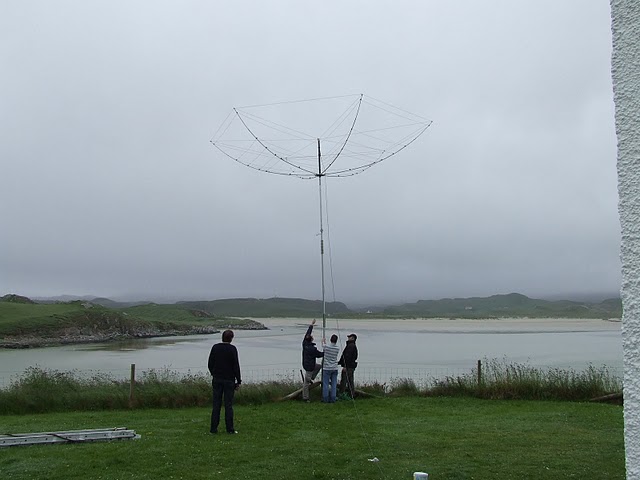 Thursday June 17th, would see the team assemble and experiment with all equipment. The G3TXQ Hexbeam worked very well in testing and we were confident in erecting it on the Flannan Isles. (This is testament to MW0JZE’s instructions). Soon MM/IZ7ATN, MM/F4BKV & MM/EA2TA had pileups as it seemed the waiting world knew our next stop would hopefully be EU-118. That evening we were all buzzing as word spread that a landing would likely be possible due to continued good sea state. We retired for the night at 0100 local, ready for the “off” at 0800 on Friday, June 18.
Thursday June 17th, would see the team assemble and experiment with all equipment. The G3TXQ Hexbeam worked very well in testing and we were confident in erecting it on the Flannan Isles. (This is testament to MW0JZE’s instructions). Soon MM/IZ7ATN, MM/F4BKV & MM/EA2TA had pileups as it seemed the waiting world knew our next stop would hopefully be EU-118. That evening we were all buzzing as word spread that a landing would likely be possible due to continued good sea state. We retired for the night at 0100 local, ready for the “off” at 0800 on Friday, June 18.
Friday was a truly beautiful day. Clear skies and a gentle breeze. Perfect for a sailing out into the Atlantic.We left our mooring at 0900 and soon Sea Trek boat charter had us on the high seas looking for Basking sharks we saw one or two, adding to our already excited minds. After 90 mins at sea, from the distance the Flannan Isles appeared. At first glance they looked tiny, then they grew, and grew…. 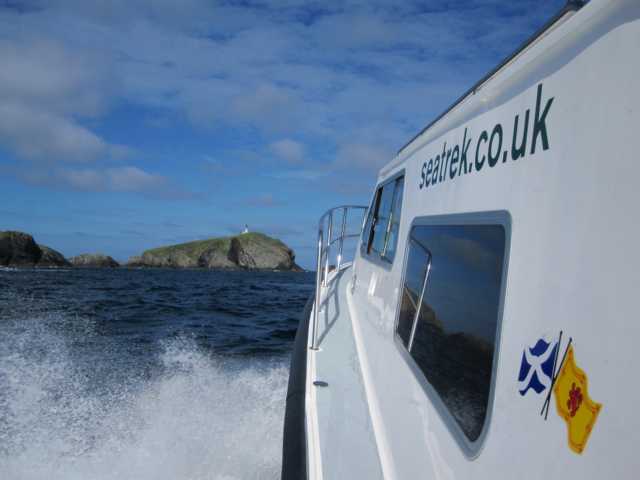
Eilean Mor….. gets closer
On approach, jaws dropped as we looked up at the sheer scale of the islands. Eilean Mor (main island with the lighthouse) now made us feel tiny! Our skipper Ian (a very funny guy) surveyed the best landing site. Either east or west would be possible most unusual. He opted for the slightly “easier” east landing as we had a good amount of equipment which needed hauled up by rope onto a platform just above this particular landing site. We anchored, and then two at a time on a small hard zodiac, we headed for the east landing. First operator to land on Flannans was Christian EA3NT, followed by Bjorn SM0MDG. Congratulatory pictures were taken and instantly sent to Niko DD1MAT, our webmaster in Germany. For some unexplained reason we never did have cell phone coverage again after the initial first landing picture was taken. Perhaps this was a curse of the lighthouse keepers who disappeared some 110 years earlier?! That story is well documented on Wikipedia. Once we all landed, we breathed a huge sigh of relief and immediately got to work in hauling up all our gear from the zodiac to the platform.
The steps at the east landing are not in good condition, although considerably better than the west side!. 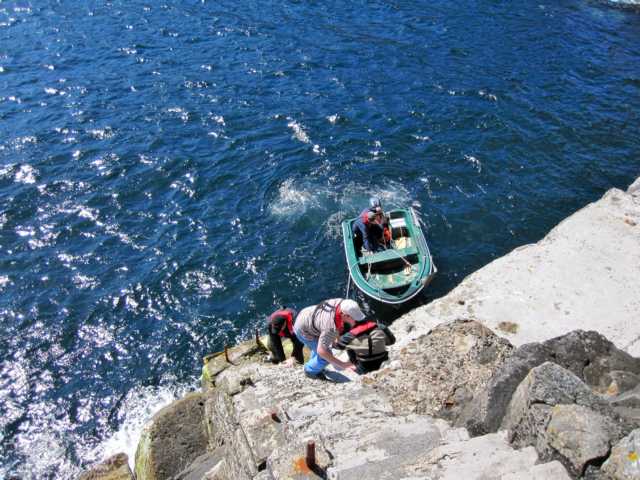 One small slip could have been fatal so we really had to be aware when we ascended. As we climbed further, the steps were in better condition. The climb itself is steep and tiring. It takes 45 mins from landing to reaching the island lighthouse, some 88m (264ft) in height. We had to do this trip three or four times with heavy equipment, food, water and outdoor gear all hoisted on our backs, with each arm stretched out carrying other pieces of equipment. I think adrenalin covered the fact we were hurting carrying all this gear.
One small slip could have been fatal so we really had to be aware when we ascended. As we climbed further, the steps were in better condition. The climb itself is steep and tiring. It takes 45 mins from landing to reaching the island lighthouse, some 88m (264ft) in height. We had to do this trip three or four times with heavy equipment, food, water and outdoor gear all hoisted on our backs, with each arm stretched out carrying other pieces of equipment. I think adrenalin covered the fact we were hurting carrying all this gear.
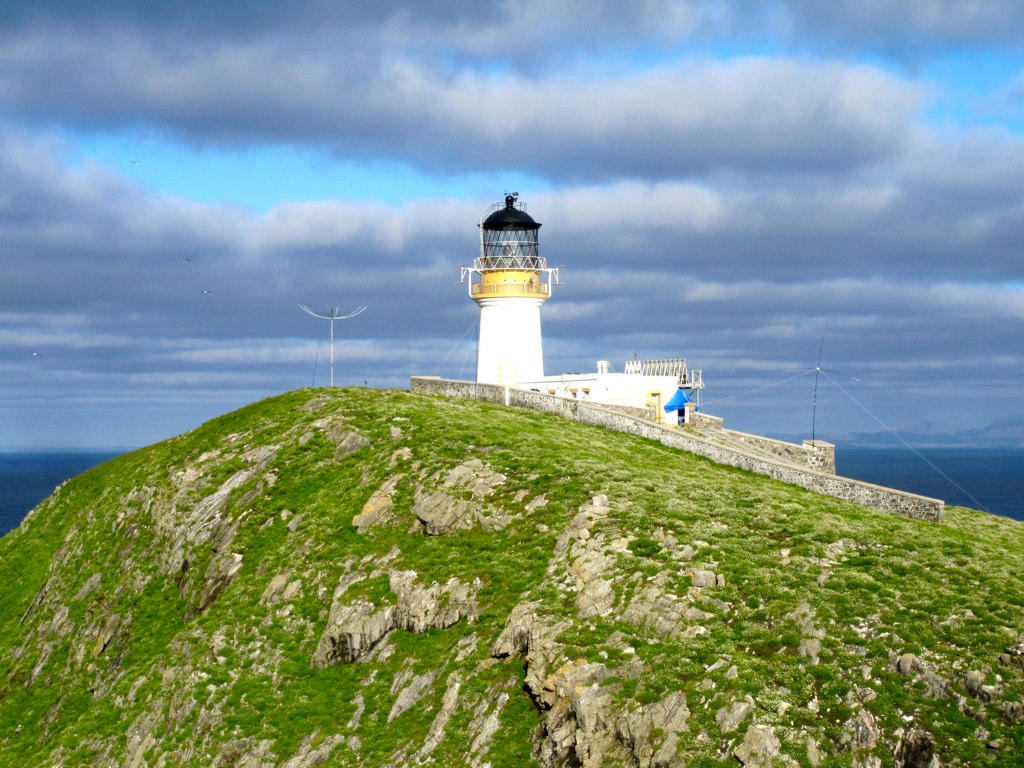 We quickly realised the lighthouse was a perfect base. The take off for all antennas was ideal.
We quickly realised the lighthouse was a perfect base. The take off for all antennas was ideal.
Ocean upon ocean with no obstacles in our way. The area below the solar panels of the lighthouse would be our “shack”. Three lightweight tarpaulins were used to provide a waterproof shelter/roof. Remains of an old outhouse building next to the lighthouse would now be our cooking area. Near to the ruined chapel we pitched tents. The Hexbeam was the first antenna to be erected thanks to Vincent F4BKV and Simon’s IZ7ATN efficiency. We decided not to begin operations on three bands simultaneously as the main target was to give out as many QSO’s as quickly as possible. To wait until all stations were complete would waste valuable “On Air” time.
“CQ, CQ, MS0INT, EU-118 Flannan Isles”
Shortly after 16:30 local on Friday June 18th, Christian EA3NT was first to transmit on 14260Mhz. “CQ, CQ, MS0INT, EU-118 Flannan Isles”. Instantly, Ukraine was first to make the log, followed by JA8MS. Within one minute, and being spotted on the DX Cluster, the pileup was as we expected HUGE! The first 100 stations were logged in no time. By end of day, two stations were on air, and we quickly made 2000 QSO’s. The opening to Japan on 20m was particularly pleasing as we knew how much EU-118 was needed there.
CW ops were EA3NT & SM0MDG. A special mention to them for working through the following nights as the SSB camp slept! By Saturday morning June 19th, we had two HF stations and 6m (50Mhz) on air. Pileups were impressive and we noted how well behaved/controlled the callers were. Deliberate QRM appeared non-existent, which was pleasing to say the least. By end of Saturday, 4000 QSO’s in just over 24 hours were made. We were delighted. Oh, and we got sunburt too! However, by late Saturday afternoon, poor weather soon approached. A party from the Hebridean Book Trust were due to visit and land the Flannan’s on the Saturday. Sadly for them the sea state was too rough to land. For us, we knew that landing on the islands at all was lucky, to depart three days later without any issues would be exceedingly lucky!
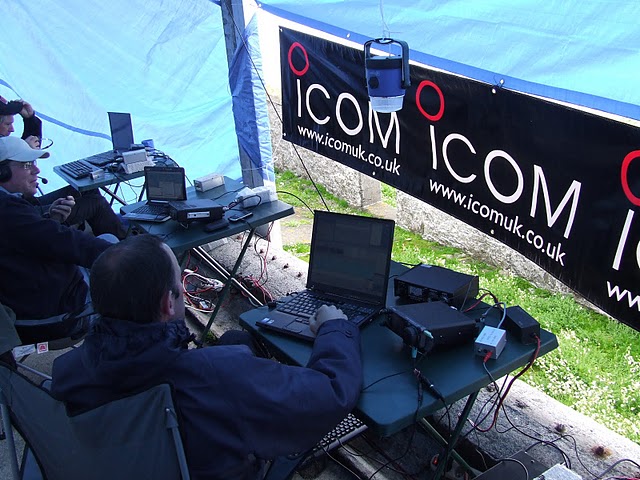 Sunday, June 20th was a difficult day, weather-wise. The wind was blowing from the north making it feel nothing like summer! The rain and low level cloud added to an already miserable weather day. Coupled with this, the seas were far choppier than previous days, and I personally believed we would not get off the island on Monday morning such was the change in conditions. Of course we couldn’t do anything about this, so continued to operate 24/7. 10m was going great guns on Sunday. Whole of Europe seemed like they were calling in. Split operation was a necessity until the pileup eased a little. Other bands continued to impress, with JA being worked easily on 17, 20 and 30m. By end Sunday, we erected the 80m dipole as we knew some ops needed EU-118 on this band for an all time new one. Propagation was not good on 80m daylight never really left us but we soldiered on and made approx 100 QSO’s on a seemingly dead band. After midnight on Sunday, we continued to run 3 stations, and with contacts being worked so very quickly, the QSO count reached 7000 in 55 hours of operating.
Sunday, June 20th was a difficult day, weather-wise. The wind was blowing from the north making it feel nothing like summer! The rain and low level cloud added to an already miserable weather day. Coupled with this, the seas were far choppier than previous days, and I personally believed we would not get off the island on Monday morning such was the change in conditions. Of course we couldn’t do anything about this, so continued to operate 24/7. 10m was going great guns on Sunday. Whole of Europe seemed like they were calling in. Split operation was a necessity until the pileup eased a little. Other bands continued to impress, with JA being worked easily on 17, 20 and 30m. By end Sunday, we erected the 80m dipole as we knew some ops needed EU-118 on this band for an all time new one. Propagation was not good on 80m daylight never really left us but we soldiered on and made approx 100 QSO’s on a seemingly dead band. After midnight on Sunday, we continued to run 3 stations, and with contacts being worked so very quickly, the QSO count reached 7000 in 55 hours of operating.
1am Monday morning, June 21st Bjorn SM0MDG and Col MM0NDX are working 30 and 40m respectively. NA, SA all loud. A small amount of whisky continues to keep us warm, as Christian EA3NT prepares to take over the 30m CW station at 3am. Everyone else is now asleep! A few hours later, three stations back on air, and I’m amazed at the number of stations still calling in. 20m has a pileup which resembles the opening of MS0INT operations three days earlier. Unbelievable! Sadly, we had to take two stations off air at 0800z on Monday morning. The boat was coming and already visible on the horizon as we disassembled. 20m SSB would keep going until the last minute. At 1000z local, MS0INT ceased operations.
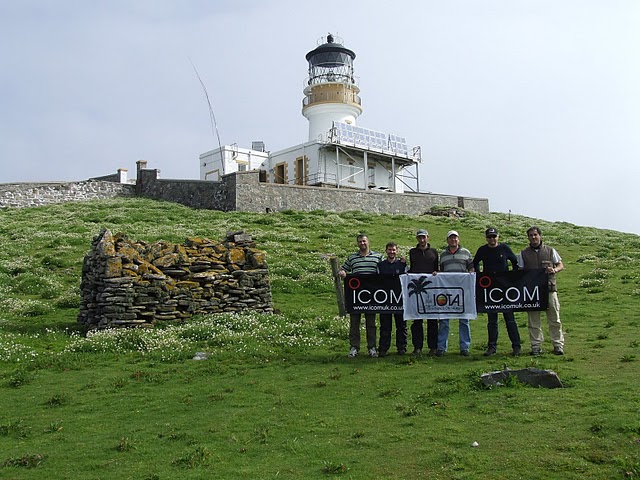 Once packed up, we had to carry all gear back down the steep descent of Eilean Mor. This was no fun as we learned we would not be using the platform used to haul the equipment up on arrival. We would need to use the broken steps at the bottom of the east landing as our return boat was a RIB (we used motor vessel Lochlann on the outward journey to Flannans . George EA2TA was the mainstay of this “operation” as we passed gear down to him who inturn passed onto Bjorn who was already on the RIB. Suffice to say, a little bit of the Atlantic soaked George as the swell kicked up!
Once packed up, we had to carry all gear back down the steep descent of Eilean Mor. This was no fun as we learned we would not be using the platform used to haul the equipment up on arrival. We would need to use the broken steps at the bottom of the east landing as our return boat was a RIB (we used motor vessel Lochlann on the outward journey to Flannans . George EA2TA was the mainstay of this “operation” as we passed gear down to him who inturn passed onto Bjorn who was already on the RIB. Suffice to say, a little bit of the Atlantic soaked George as the swell kicked up!
Finally at 11:05z on June 21st we left EU-118. Happy. A total of 8,273 QSO’s were made in 66 hours. 5,661 Unique call signs.
The journey back to EU-010 was very fast aboard the RIB. By 12pm local were back on terra firma, unloading. Our hire bus was at the pier so we quickly got organised and drove to our base camp a few miles south. A much needed shower was the order of the day! Nobody felt like transmitting that evening! We had smoked salmon, wine and some beers, and then hit the sack, still high on adrenalin after a brilliant three days on Flannan Isles.
The team wishes to thank everyone who called in, no matter how many times you made the log. Every QSO was welcome and we’re delighted EU-118 is now so much less wanted, particulary for Japan. Special thanks to CDXC (Clipperton), GDXF, F5CWU for the loan of band pass filters, Norman GM4KGK for local support, Niko DD1MAT for maintaining & updating our website, AHC, SeaTrek and everyone who kindly donated. We also acknowledge the Sea Gods
were with us!
QSL cards will be available within the next few weeks. Planning for our next trip has already started.
Col, MM0NDX
On behalf of MS0INT Team
Photographs by courtesy of Bjorn SM0MDG & George, EA2TA.

